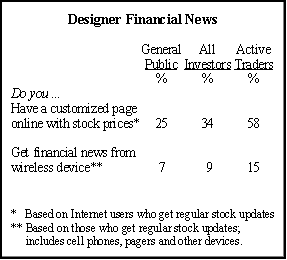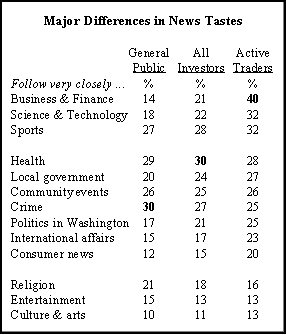While the crowded landscape has fragmented audiences, it has given the most sophisticated and technology-savvy news consumers an array of options that would have been inconceivable just a few years ago. Americans who are active stock traders and investors are perfectly positioned to take advantage of these choices.
Active traders — those who have bought or sold stock within the last six months — make up only 15% of the population. But reflecting the extent to which high-income Americans now participate in the market, active traders comprise nearly half (45%) of all of those with family incomes of $100,000 or more. Fully nine-in-ten (89%) of those making at least $100,000 are investors, though not as actively engaged.1
Not surprisingly, active traders have a strong interest in financial news. Fully eight-in-ten (81%) get stock market updates at least once a week and nearly half (45%) get this information on a daily basis. By contrast, 59% of all investors get weekly market updates and 25% check in daily. Among the public, 42% get weekly updates and just 16% get stock information every day.
But what may be most striking about active investors is their extraordinary access to and familiarity with the technological tools of the new information environment. A few years ago, active investors in search of news on the stock market would have been limited to a handful of newspapers and television programs; today, by far their leading source for such information is the Internet.
Nearly half (45%) of active traders turn first to the Internet for stock updates and quotes, with television (24%) running a distant second. By contrast, all investors and the public are more inclined to rely on traditional media — television and newspapers — for stock updates. The preferences of all investors are divided among television (30%), the Internet (28%) and newspapers (26%), while television is clearly the public’s main source for such news (at 37%).
Active traders are also more likely to go online for investment advice. More than one-third (35%) say they go online for information on how and where to invest, compared to 19% who turn to televison and 18% who use newspapers. An additional 12% volunteered that they rely on a stock broker or a financial adviser for this type of information.
Customized Financial News
Active traders not only go online for financial news in greater numbers than all investors or the general public, they also are more likely to possess other communications tools such as cell phones and pagers. While more than eight-in-ten (82%) active investors own a home computer, 70% have a cell phone and 29% have a pager.

With access to a broad range of information technology, active traders are able to tailor their financial news to suit their personal needs and interests. For instance, nearly six-in-ten (58%) active traders who go online for stock updates have a customized online web page that provides prices and other information on their stock portfolio. Roughly one-third (34%) of all investors who go online for market updates (and 25% of all Internet users who go online for this purpose) have such customized portfolios. Moreover, 15% of active traders sometimes use cell phones, pagers or other wireless devices for stock quotes and market updates. Just 9% of all investors and 7% of the public use these technologies to do so.
Access to technology — and the wide range of information sources — helps to give active investors considerable autonomy in making investment decisions. Nearly two-thirds of this group (66%) say they are extremely involved making those decisions; fully nine-in-ten (94%) are at least somewhat involved.
All investors and the public are also personally involved in formulating investment strategies — but to a lesser degree than active traders. Just under half of investors (49%) and the public (48%) say they are extremely involved in making investment-related decisions, while 17% of investors and 23% of the public say they are uninvolved or are minimally involved in making investment decisions.
CNBC Rated Highly
Active traders also turn to different television outlets and newspapers for stock quotes and investment advice, compared to all investors or the public. Cable dwarfs broadcast news in the preferences of those active traders who name television as their main source for market updates.
Again among those active traders who rely on TV for updates, nearly eight-in-ten (77%) say they turn most often to cable outlets, against 14% who most frequently tune in to local or network broadcast news. CNBC is the top choice of active investors who identify television as their main source (at 36%). The percentage of active investors who name CNBC is more than double the percentages of those who tune into local (7%) and network news (7%) combined.
Generally, investors and members of the public who identify television as their main source for market information turn most often to CNN or its cable partner CNNfn (30% of all investors and 28% of the public). But one-in-five (21%) investors and more than a quarter of the public (26%) say they still turn to local television news for stock updates.
Active traders also are more likely than all investors and the public to tune into cable outlets when they are seeking investment advice. Among those who would go first to television for this type of information, CNBC is named most often (at 31%), with CNN/CNNfn second at 27%. All investors divide their preferences between CNN/CNNfn (27%) and local news (25%); the public does so as well, with 27% citing local news and 25% naming CNN/CNNfn.
Among those who choose newspapers as their primary source for stock market news, majorities of active traders (53%), all investors (74%) and the public (71%) turn first to their local papers for stock updates. But fully one-quarter of active investors rely on the Wall Street Journal, significantly more than all investors (12%) or the public (15%).
Beyond Financial News
Active traders are heavy consumers of news on many different subjects — not just financial news and advice — and they get information from a variety of sources. Despite their strong preference for surfing the web for business-related news, the vast majority of active investors have not abandoned traditional media.
Active traders regularly tune into the nightly network news programs at a slightly higher rate (37%) than either all investors (33%) or the general public (30%). Nearly six-in-ten active traders (59%) regularly tune into local news programs, about the same as all investors (58%) and the public (56%).
Nearly three-quarters (73%) of active traders are regular newspaper readers, about the same as all investors (69%) and somewhat more than the public (62%). Nearly six-in-ten active investors (58%) say they read a newspaper yesterday, compared with 53% of all investors and 46% of the public.

Beyond financial news, active traders are most interested in following news on science and technology, as well as sports. Nearly one-third (32%) follow news on science and technology very closely, while 22% of all investors and 18% of the public say the same. Active traders also have relatively high interest in international news (23% following it very closely). But stories on crime and religion have less appeal to active investors than they do to the public.
Internet Takes a Modest Toll
For a minority of active traders, however, the availability of news on the Internet has cut into their consumption of news from other media — especially newspapers. While most (58%) say there has been no change in their overall news consumption since they started getting news online, about one-in-five are going to other news sources less often. Nearly half (46%) of active traders who have cut their use of traditional media since going online say they are reading newspapers less often, while 40% watch television news less.
Still, the vast majority of active traders are fairly content with the news offerings of the traditional media. More than three-quarters (78%) say they are satisfied with TV news programming, about the same as all investors and the general public. An overwhelming majority (92%) of active traders say they get at least some enjoyment out of keeping up with the news, compared to 91% of all investors and 85% of the public. Four-in-five (80%) active investors disagree with the idea that the news is less important than it once was.
Perhaps most important, while many active investors opt for customized, online financial information, they have little interest in tailoring all news in that manner. Nearly seven-in-ten (68%) active investors prefer to get general information about important events — about the same percentage as all investors (71%) and the public (67%) — while 26% would rather have news mostly about their interests.




